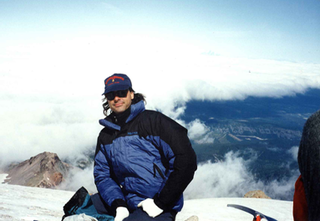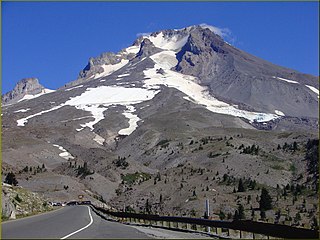Related Research Articles

An emergency position-indicating radio beacon (EPIRB) is a type of emergency locator beacon, a portable, battery-powered radio transmitter used in emergencies to locate airplanes, vessels, and persons in distress and in need of immediate rescue. In the event of an emergency, such as a ship sinking or an airplane crash, the transmitter is activated and begins transmitting a continuous radio signal, which is used by search-and-rescue teams to quickly locate the emergency and render aid. The signal is detected by satellites operated by an international consortium of rescue services, COSPAS-SARSAT, which can detect emergency beacons anywhere on Earth transmitting on the COSPAS distress frequency of 406 MHz. The consortium calculates the position of the beacon and quickly passes the information to the appropriate local first responder organization, which performs the search and rescue. The basic purpose of this system is to help rescuers find survivors within the so-called "golden day" during which the majority of survivors can usually be saved. The feature distinguishing a modern EPIRB, often called GPIRB, from other types of emergency beacon is that it contains a GPS receiver and broadcasts its position, usually accurate within 100 m (330 ft), to facilitate location. Previous emergency beacons without a GPS can only be localized to within 2 km (1.2 mi) by the COSPAS satellites.

Mount Hood is a potentially active stratovolcano in the Cascade Volcanic Arc. It was formed by a subduction zone on the Pacific coast and rests in the Pacific Northwest region of the United States. It is located about 50 miles (80 km) east-southeast of Portland, on the border between Clackamas and Hood River counties. In addition to being Oregon's highest mountain, it is one of the loftiest mountains in the nation based on its prominence, and it offers the only year-round lift-served skiing in North America.
A distress signal, also known as a distress call, is an internationally recognized means for obtaining help. Distress signals are communicated by transmitting radio signals, displaying a visually observable item or illumination, or making a sound audible from a distance.

A cell site, cell tower, or cellular base station is a cellular-enabled mobile device site where antennas and electronic communications equipment are placed—typically on a radio mast, tower, or other raised structure—to create a cell in a cellular network. The raised structure typically supports antenna and one or more sets of transmitter/receivers transceivers, digital signal processors, control electronics, a GPS receiver for timing, primary and backup electrical power sources, and sheltering.

Oregon Episcopal School (OES) is an American private, coeducational, college preparatory, day and boarding school in the Raleigh Hills area of Portland, Oregon.

The Mount Hood Wilderness is a protected wilderness area inside the Mount Hood National Forest, in the U.S. state of Oregon. The area, covering 64,742 acres (26,200 ha), includes the peak of Mount Hood and its upper slopes, and ranges from temperate rain forests at the lower elevations, to glaciers and rocky ridges at higher elevations.

The International Cospas-Sarsat Programme is a satellite-aided search and rescue (SAR) initiative. It is organized as a treaty-based, nonprofit, intergovernmental, humanitarian cooperative of 45 nations and agencies. It is dedicated to detecting and locating radio beacons activated by persons, aircraft or vessels in distress, and forwarding this alert information to authorities that can take action for rescue.
A GPS tracking unit, geotracking unit, or simply tracker is a navigation device normally on a vehicle, asset, person or animal that uses the Global Positioning System (GPS) to determine its movement and determine its WGS84 UTM geographic position (geotracking) to determine its location.GPS tracking devices send special satellite signals that are processed by a receiver.

Jeffrey Kelly James was one of three experienced mountain climbers who died on Mount Hood in the U.S. state of Oregon in December 2006 in an incident which received worldwide attention.
Velvet is a black lab-shepherd cattle mixed-breed dog, owned by Matty Bryant of Milwaukie, Oregon, who helped save three climbers, including Bryant, when they became stranded on Mount Hood, Oregon, on February 18, 2007.

In navigation, a radio beacon is a kind of beacon, a device that marks a fixed location and allows direction-finding equipment to find relative bearing. Radio beacons transmit a radio signal that is picked up by radio direction-finding systems on ships, aircraft and vehicles to determine the direction to the beacon.
Global Navigation Satellite System (GNSS) receivers, using the GPS, GLONASS, Galileo or BeiDou system, are used in many applications. The first systems were developed in the 20th century, mainly to help military personnel find their way, but location awareness soon found many civilian applications.

Multnomah County Sheriff's Office Search and Rescue is a non-profit volunteer search and rescue resource for the Multnomah County Sheriff's Office in Multnomah County, Oregon, United States. The agency also offers its 3,000-5,000 hours of volunteer service to other areas, including Clackamas, Columbia, Washington, Marion, Hood River, Wasco, Tillamook, and Clatsop counties in Oregon, and Skamania and Clark counties in Washington. The organization was first created in 1961 in cooperation with the Boy Scouts of America, and is one of the longest continually used Explorer Search and Rescue units in the United States. In 1986, sponsorship of the MCSO SAR was transferred to the Multnomah County Sheriff's Office. MCSO SAR is part of the Mount Hood Search and Rescue Council. MCSO receives funding from the Department of Homeland Security within the Urban Area Security Initiative (UASI) to create a regional resource.

Mount Hood climbing accidents are mountain climbing- or hiking-related incidents on Oregon's Mount Hood. As of 2007, about 10,000 people attempt to climb Mount Hood each year. As of May 2002, more than 130 people have died climbing Mount Hood since records have been kept. One of the worst climbing accidents occurred in 1986, when seven teenagers and two school teachers froze to death while attempting to retreat from a storm.

Radio is the technology of signaling and communicating using radio waves. Radio waves are electromagnetic waves of frequency between 30 hertz (Hz) and 300 gigahertz (GHz). They are generated by an electronic device called a transmitter connected to an antenna which radiates the waves, and received by another antenna connected to a radio receiver. Radio is very widely used in modern technology, in radio communication, radar, radio navigation, remote control, remote sensing, and other applications.
In the United States, mountain rescue is handled by professional teams within some national parks and by volunteer teams elsewhere. Volunteer teams are often members of the Mountain Rescue Association (MRA).
A Satellite Emergency Notification Device or SEND is a portable emergency notification and locating device which uses commercial satellite systems rather than the COSPAS-SARSAT satellite system. An example of this device is SPOT.
Portland Mountain Rescue is a search and rescue organization based in Portland, Oregon, United States. It specializes in high angle mountain rescue and mountain rescue in northwest Oregon and southwest Washington, as well as providing educational materials and information on mountain and backcountry safety. Secondary areas of operations include Central Oregon and western Washington. The organization is 100% volunteer and has about 65 field-deployable members.
An emergency locator beacon is a radio beacon, a portable battery powered radio transmitter, used to locate airplanes, vessels, and persons in distress and in need of immediate rescue. Various types of emergency locator beacons are carried by aircraft, ships, vehicles, hikers and cross-country skiers. In case of an emergency, such as the aircraft crashing, the ship sinking, or a hiker becoming lost, the transmitter is deployed and begins to transmit a continuous radio signal, which is used by search and rescue teams to quickly find the emergency and render aid. The purpose of all emergency locator beacons is to help rescuers find survivors within the so-called "golden day", the first 24 hours following a traumatic event, during which the majority of survivors can usually be saved.

The 1986 Mount Hood Disaster occurred in May 1986, when seven students and two members of staff from Oregon Episcopal School died during an excursion on Mount Hood. The students were participating in an adventure program required by the school for sophomores. The disaster is the second deadliest alpine accident in North American history, behind an avalanche in 1981 on Mount Rainier which claimed eleven lives.
References
- 1 2 "Mountain Locator Unit could have helped two climbers". The Oregonian. Retrieved 2007-04-01.
- ↑ "Portland Mountain Rescue: Search for Missing Mt Hood Snowshoer Ends". Archived from the original on 2006-09-25. Retrieved 2007-02-19.
- ↑ "Mount Hood - The Episcopal School Tragedy" . Retrieved 2007-02-19.
- ↑ "PLB rental information". PLB Rentals, LLC. Retrieved 2007-02-20.
- ↑ iain (2006-12-16). "Mountain Locator Units on Mount Hood" . Retrieved 2008-07-04.
- ↑ L. David Mech; Shannon M. Barber (2002-02-06). "A Critique of Wildlife Radio Tracking and its Use in National Parks—A Report to the U.S. National Park Service" (PDF). p. 12. Retrieved 2008-07-04.
- ↑ "Oregon bill would require climbers to carry beacons". CNN / Associated Press. February 19, 2007. Archived from the original on 2007-02-21. Retrieved 2007-02-20.
- ↑ A-Engrossed House Bill 2509 Archived 2007-08-10 at the Wayback Machine
- ↑ Har, Janie (March 29, 2007). "House OKs mandate for Hood locators". The Oregonian. Retrieved 2007-03-30.
- ↑ 2007 Oregon House Measure History Archived 2007-03-20 at the Wayback Machine
- ↑ "Oregon HB2509 mandates electronic signaling devices on Mount Hood—Climbers' Views". 2007-10-19. Retrieved 2008-07-03.